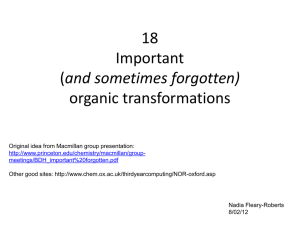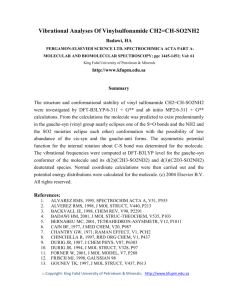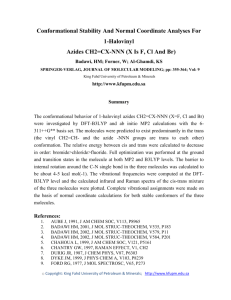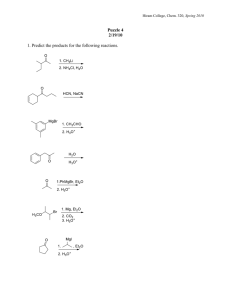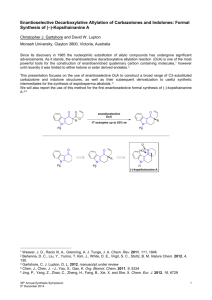View Essay - ACS Organic Division
advertisement
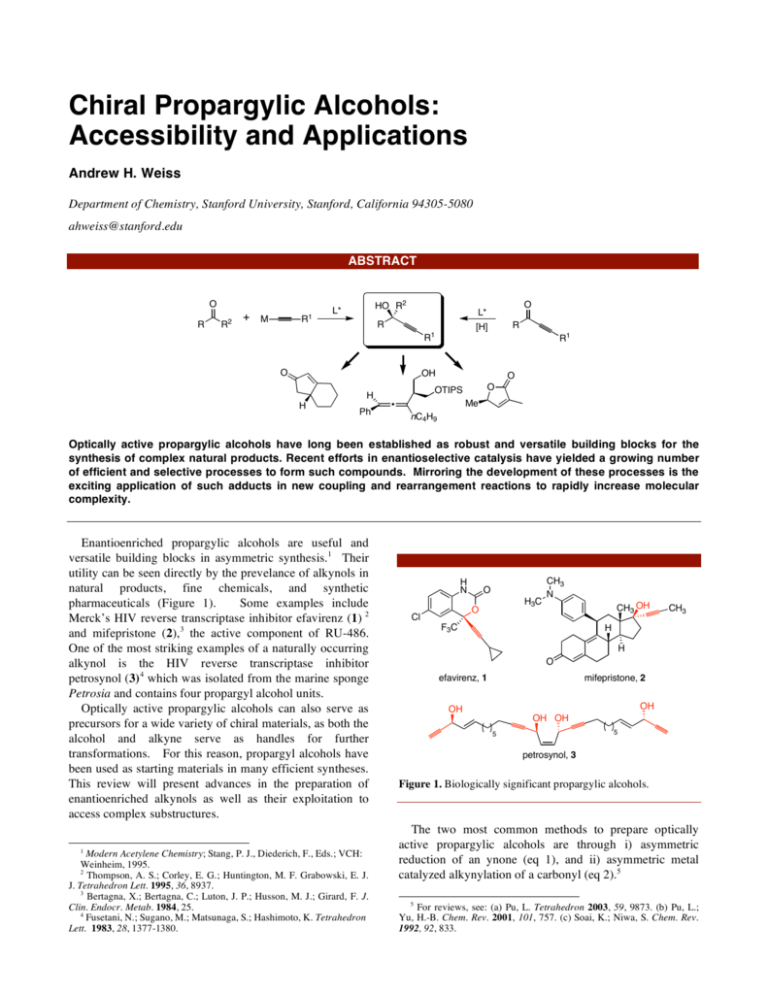
Chiral Propargylic Alcohols: Accessibility and Applications Andrew H. Weiss Department of Chemistry, Stanford University, Stanford, California 94305-5080 ahweiss@stanford.edu ABSTRACT O R R2 + M R1 HO R2 L* O L* R O R [H] R1 R1 OH H H Ph O O OTIPS Me • nC4H9 Optically active propargylic alcohols have long been established as robust and versatile building blocks for the synthesis of complex natural products. Recent efforts in enantioselective catalysis have yielded a growing number of efficient and selective processes to form such compounds. Mirroring the development of these processes is the exciting application of such adducts in new coupling and rearrangement reactions to rapidly increase molecular complexity. Enantioenriched propargylic alcohols are useful and versatile building blocks in asymmetric synthesis.1 Their utility can be seen directly by the prevelance of alkynols in natural products, fine chemicals, and synthetic pharmaceuticals (Figure 1). Some examples include Merck’s HIV reverse transcriptase inhibitor efavirenz (1) 2 and mifepristone (2),3 the active component of RU-486. One of the most striking examples of a naturally occurring alkynol is the HIV reverse transcriptase inhibitor petrosynol (3) 4 which was isolated from the marine sponge Petrosia and contains four propargyl alcohol units. Optically active propargylic alcohols can also serve as precursors for a wide variety of chiral materials, as both the alcohol and alkyne serve as handles for further transformations. For this reason, propargyl alcohols have been used as starting materials in many efficient syntheses. This review will present advances in the preparation of enantioenriched alkynols as well as their exploitation to access complex substructures. 1 Modern Acetylene Chemistry; Stang, P. J., Diederich, F., Eds.; VCH: Weinheim, 1995. 2 Thompson, A. S.; Corley, E. G.; Huntington, M. F. Grabowski, E. J. J. Tetrahedron Lett. 1995, 36, 8937. 3 Bertagna, X.; Bertagna, C.; Luton, J. P.; Husson, M. J.; Girard, F. J. Clin. Endocr. Metab. 1984, 25. 4 Fusetani, N.; Sugano, M.; Matsunaga, S.; Hashimoto, K. Tetrahedron Lett. 1983, 28, 1377-1380. H N O H3C O Cl CH3 N CH3 OH F3C CH3 H H O mifepristone, 2 efavirenz, 1 OH OH OH OH 5 5 petrosynol, 3 Figure 1. Biologically significant propargylic alcohols. The two most common methods to prepare optically active propargylic alcohols are through i) asymmetric reduction of an ynone (eq 1), and ii) asymmetric metal catalyzed alkynylation of a carbonyl (eq 2).5 5 For reviews, see: (a) Pu, L. Tetrahedron 2003, 59, 9873. (b) Pu, L.; Yu, H.-B. Chem. Rev. 2001, 101, 757. (c) Soai, K.; Niwa, S. Chem. Rev. 1992, 92, 833. O L* R1 R + M R [1] R R1 asymmetric reduction O 2 OH [H] R R1 While these stoichiometric reductants produce the desired propargylic alcohols with high chemical and optical yields, and are often recoverable, a more atom economical9 method was desirable. Corey’s proline-derived oxazaborolidine10 provides a reliable, catalytic enantioselective reduction of ynones11 using catecholborane as the stoichiometric reductant. One of the greatest advances in the field of ynone reductions, however, is the recent use of transfer hydrogenation (Scheme 1). Using only 0.5 mol% of Noyori’s chiral Ru complex, ynones can be reduced with extremely high yields and ee’s under mild neutral conditions.12 HO L* R2 [2] R asymmetric alkynylation R1 One of the most reliable and extensively studied methods to form chiral propargyl alcohols is the reduction of prochiral ynones (eq 1). Facile access to a variety of chiral boranes spurred the early development of this area. Alpine-borane,6,7 and later DIP-Cl8 (B-chlorodiisopinocampheylborane) were found to enantioselectively reduce ynones (Figure 2). These reagents are easily prepared from α-pinene (eq 3) and can be recovered from the reaction mixture. Alpine-borane achieves high enantioselectivity for sterically unhindered ynones, but does not reduce sterically demanding ynones such as α-tBu (eq 4). In contrast, DIP-Cl functions optimally with sterically demanding ynones, while enantioselectivity degrades with less sterically hindered substrates (eq 5). BCl 1. BH3 SMe2 2 B 9-BBN [3] 2. HCl Alpine-Borane (+)-pinene DIP-chloride Alpine-Borane: Reduces sterically unhindered ynones O OH Alpine-Borane R [4] R 8 hr, rt R = iPr: 78% (91% ee) R= tBu: no product DIP-Chloride: Reduces sterically hindered ynones O OH DIP-Cl 2-8 hr, -25 oC R Ph R = Me: Et: iPr: tBu: [5] R 92%, 21% ee 90%, 28% ee 85%, 53% ee 80%, 98% ee Ph Figure 2. Pinene-derived chiral reducing agents. Scheme 1. Noyori’s asymmetric yransfer hydrogenation.12 Ph O Ru Ar N H Ar = n6 - Mesityl, p-cymene Ph R2 R1 R1 = alkyl, aryl, TMS R2 = alkyl (0.5 mol%) i-PrOH OH R2 R1 [6] 11 examples yield >90%, ee 94-99% Although a tremendous amount of work has led to highly enantioselective catalytic hydrogenations, application of these methods is ultimately limited by the necessity of an ynone starting material. Ynones are accessible, however the functional group suffers from a propensity to decompose, to isomerize to allenyl ketones, or to react as potent Michael acceptors. Also, by virtue of hydrogen addition, reduction cannot give access to tertiary alkynols. One solution to this problem is the application of alkyl additions to an ynone. There has been a great deal of fruitful research addressing this problem,13 but alkyl additions are often complicated by ynone instability as well and the high reactivity of the metalated alkyl group. The addition of a terminal acetylide to an aldehyde5 (eq 2) alleviates both of these strategic concerns. There is no necessity for an ynone or ynal as the carbonyl partner; any aldehyde or ketone can be attacked to furnish a propargylic alcohol. Also, the high kinetic acidity of terminal alkynes (pKa = 25 in organic solvents) allows for their facile deprotonation and metalation under mild conditions. Alkynylation of a ketone (eq 2, R2 ≠ H) grants access to tertiary carbinol centers. Also, the addition of an acetylide has the possibility to yield a convergent synthesis, adjoining two complex pieces while forming a stereocenter. 9 Trost, B. M. Science, 1991, 254, 1471. Corey, E. J.; Bakshi, R.; K.; Shibata, S.; Chen, C.-P.; Singh, V. K. J. Am. Chem. Soc. 1987, 109, 7925. 11 Corey, E. J.; Helal, C. J. Tetrahedron Lett. 1995, 36, 9153. 12 Matsumura, K.; Hashigushi, S.; Ikarya, T.; Noyori, R. J. Am. Chem. Soc. 1997, 119, 8738. 13 Jeon, S.-J.; Li., H.; Garcia, C.; LaRochelle, L. K.; Walsh, P. J. J. Org. Chem. 2005, 70, 448 and references therein. 10 6 Midland, M. M.; McDowell, D. C.; Hatch, R. L.; Tramontano, A. J. Am. Chem. Soc. 1980, 102, 867. 7 Midland, M. M.; Tramontano, A.; Bazubski, A.; Graham, R. S.; Tsai, D. J. S.; Cardin, D. B. Tetrahedron, 1984, 40, 1371. 8 Brown, H. C.; Chandrasekharan, J.; Ramachandran, P. V. J. Am. Chem. Soc. 1988, 110, 1539. Ts N Scheme 2. Zn-catalyzed asymmetric alkynylation.16 nBu2N OH Me Ph OH O R2 R2 R1 Zn Et 2.0 equiv H = alkyl, aryl R1 R2 R1 (5 mol%) 23 oC = alkyl, aryl [7] R1=R2= Ph 95% (40% ee) Numerous methods for diastereoselective14 and enantioselective5 alkynylation of carbonyls have been reported. The first enantioselective addition of a terminal acetylide to an aldehyde catalyzed by a chiral amino alcohol was reported by the Mukaiyama group15 in 1979. Because a lithium acetylide was used, the reaction had to be carried out at extremely low temperatures (-123 oC) to avoid the ligandless, racemic background reaction. By switching to Zn alkynylides (Scheme 2), the Soai group was able to carry out enantioselective alkynylations at room temperature without observing the racemic background reaction.16 These important experiments paved the way for a wealth of protocols to alkynylate aldehydes.5 Although capable of forming secondary propargylic alcohols in high yield and ee, these processes are limited by sensitivity to air and water, the necessity for a large excess of metalated alkyne, and by the inability to alkynylate ketones. These three limitations are currently being addressed in this active area of research. Table 1. Carreira’s ephedrine mediated alkynylation.17 sensitive dialkyl zinc species, metalation with Zn(OTf)2 and an amine base is tolerant to air and moisture (Table 1, entry 1 vs 2). Complexation of the alkyne with Zn(OTf)2 increases the acidity of the alkyne, allowing deprotonation with simple alkyl amine bases. Furthermore, this methodolgy allows a nearly 1:1 ratio of aldehyde:alkyne to be used, and in an impressive feat of atom economy, the reaction can be performed neat (Table 1, entry 6).17c These conditions show broad scope with respect to aliphatic aldehydes, however, unsaturated aldehydes are not ideal substrates due to a competitive Cannizzaro disproportionation reaction (Table 1, entry 5). Ketones are unreactive under these conditions. Additionly, the catalytic version of this process is not as tolerant to moisture or varied substrate scope. Table 2. Indium catalyzed alkynylation.18 OH OH O + R1 (10 mol%) OH R InBr3 (10 mol%) R1 Cy2NMe (50 mol%) 1-2 days, CH2Cl2 Time yield ee entry R R1 (h) (%) (%) 1 Ph Ph 24 84 95 2a Ph Ph 24 85 94 b 3 Ph Ph 24 85 96 4 Cy Ph 9 95 98 5 iBu -(CH2)2 Ph 48 46 98 6 iBu Ph 25 85 96 7 Cy -(CH2)2 Ph 36 77 >99 a b Reaction was performed under air. InBr 3 (2 mol%), R-BINOL (2 mol%) and Cy2NMe (10 mol%) were used. R H 2.0 equiv NMe2 CH3 O R H + R1 1.1 equiv OH OH (1.2 equiv) Et3N (1.2 equiv) Zn(OTf)2 (1.1 equiv) R R1 yield ee entry R R1 (%) (%) 1 iPr -(CH2)2 Ph 88 99 2a iPr -(CH2)2 Ph 90 99 3a Ph Ph 82 93 4 Cy TMS 93 98 5 PhCH=CH-(CH2)2 Ph 39 80 b 6 Cy TES 87 91 a) undistilled toluene was used. b) catalytic conditions used: Zn(OTf)2 (20 mol%), Et3N (50 mol%), amino alcohol (22 mol%), reaction run neat. A major contribution to this field came from the Carreira group and was based on a new method for the metalation of terminal acetylenes (Table 1).17 Alleviating the need for 14 Guillarme, S.; Ple, K.; Banchet, A.; Liard, A.; Haudrechy, A. Chem. Rev. 2006, 106, ASAP. 15 Mukaiyama, T.; K. Suzuki, K.; Soai, K.; Sato, T. Chem Lett. 1979, 447. 16 Niwa, S.; Soai, K. J. Chem. Soc., Perkin Trans. 1 1990, 937. 17 (a) Frantz, D. E.; Fassler, R.; Carreira, E. M. J. Am. Chem. Soc. 1999, 121, 11245. (b) Frantz, D. E.; Fassler, R.; Carreira, E. M. J. Am. Chem. Soc. 2000, 122, 1806. (c) Anand, N. K.; Carriera, E. M. J. Am. Recently, the alkynylation of aldehydes with high yields and ee’s was demonstrated with an indium(III)-BINOL complex (Table 2).18 While a variety of aliphatic and aromatic alkynes and aldehydes were compatible, silylprotected alkynes were not tolerated. A major advantage to this protocol is the robust nature of the catalyst, with efficiency not affected by air (Table 2, entry 2), nor by catalyst loadings as low as 2 mol% (Table 2, entry 3). Alkyne additions to carbonyl compounds remain an active area of research in the preparation of optically active propargylic alcohols. Methods to alkynylate ketones19 as well as utilizing particularly challenging propiolate20,21 donors have been recently reported. Substrate scope and Chem. Soc. 2001, 123, 9687. (d) Boyall, D. Frantz, D. E.; Carreira, E. M. Org. Lett. 2002, 4, 2605. 18 Takita, R.; Yakura, K.; Ohshima, T.; Shibasaki, M. J. Am. Chem. Soc. 2005, 127, 13760. 19 (a) Cozzi, P. G. Angew. Chem. Int. Ed. 2003, 42, 2895. (b) Lu, G.; Li, X. S.; Jia, X.; Chan, W. L.; Chan, A. S. C. Angew. Chem. Int. Ed. 2003, 42, 5057. (c) Chen, C.; Hong, L.; Xu, Z.-Q.; Liu, L.; Wang, R. Org. Lett. 2006, 8, 2277, and references therein. 20 Gao, G.; Wang, Q.; Yu, X-Q.; Xie, R-G.; Pu, L. Angew. Chem. Int. Ed. 2006, 45, 122. 21 Trost, B. M.; Weiss, A. H.; von Wagelin, A. J. J. Am. Chem. Soc. 2006, 128, 8. catalyst loadings are improving rapidly making alkynylations of carbonyls a practical synthetic method. Scheme 3. Ru-catalyzed Alder-ene with propargyl alcohols. Trost's Ancepsenolide Synthesis [CpRu(COD)Cl] (10 mol%) MeOH, reflux OH 4 CO2Et (2 equiv) O OH OEt H3C 5 7 (75%) 7 6 is interesting to note that the gold-catalyzed process has a high selectivity for the acetylenic Claisen (eq 9) while the thermal process26 has the opposite selectivity (eq 10). The Toste group reported27 a Au(I)-catalyzed Rautenstrauch rearrangement, resulting in the synthesis of chiral 2-cyclopentenones from pivaloate ester adducts readily available from the enantioselective alkynylation of α,β-unsaturated aldehydes (Scheme 4, eq 11). The chiral information at the oxygen stereocenter was transferred cleanly to the carbon stereocenter with high yield. Using mild conditions, a wide variety of substituted cyclopentenones can be efficiently prepared. O O H3C CH3 7 O [(Ph3P)3RhCl] O O O Scheme 4. Au-catalyzed rearrangements. H3C H2 (93%) O CH3 8 (+)-ancepsenolide O O OTBS nC4H9 I OEt 9 O CpRu(MeCN)3PF6 (5 mol%) CSA (52%) then NaBH4 OH OH OH O 10 O OEt Ph Acetylenic Claisen (racemic) O 11 [9] • 80% Ph thermal Allylic Claisen Bipinnatin J H then NaBH4 O I O [8] nC4H9 OH [(Ph3PAu)3O]BF4 (1 mol%) OH 12 Ph OTIPS • 81%, 94% ee, >20:1 dr I O O H Ph Trauner's Bipinnatin Synthesis OH HO [(Ph3PAu)3O]BF4 (1 mol%) O 22 For a review, see: Trost, B. M.; Frederiksen, M. U.; Rudd, M. T. Angew. Chem. Int. Ed. 2005, 44, 6630. 23 Trost, B. M.; Muller, T. J. J.; Martinez, J. J. Am. Chem. Soc. 1995, 117, 1888. 24 Roethle, P. A.; Trauner, D. Org. Lett. 2006, 8, 345. 25 Sherry, B. D.; Toste, F. D. J. Am. Chem. Soc. 2004, 126, 15978. Ph O O With improved access to chiral propargylic alcohols has come the development of numerous approaches to exploit these useful building blocks. One such process is the Rucatalyzed alkene-alkyne coupling to give Alder-ene type products (Scheme 3).22 When alkyne 4 and diene 5 are heated in methanol in the presence of a ruthenium catalyst, the bis-butenolide 7 is formed in 75% yield. This was used to rapidly access ancepsenolide23 (8) and has been used to install butenolides in several natural products including the biologically relevant (±)-bipinnatin J (12) (Scheme 3). 24 In this synthesis, both distal stereocenters were set diastereoselectively from the chirality of the propargyl alcohol. Thus, this elegant 9-step synthesis could be rendered enantioselective by using optically pure starting alkynol 9. Adducts from the enantioselective alkynylation of α,βunsaturated aldehydes are particularly useful intermediates for the construction of complex molecules. They have been shown to propagate their chiral information through Pd-catalyzed allylic alkylation21 to form a tertiary stereocenter, or through a gold-catalyzed Claisen rearrangment25 to yield chiral allenes (Scheme 4, eq 8). It [10] HO Ph3PAuSbF6 O (5 mol%), 12 hrs [11] H 93% ee 86%, 91% ee Chiral propargylic alcohols are incredibly versatile, useful, and important building blocks in modern organic chemistry. They are available through catalytic asymmetric reductions of ynones or directly by alkynylations of carbonyl compounds. Although advances in asymmetric catalysis have led to the ready access of enantioenriched secondary propargylic alcohols, research into the efficient and operationally facile preparation of tertiary carbinols19 is ongoing. In addition, the necessity for excess alkyne in most systems has hindered the employment of alkynylations in late-stage couplings of advanced intermediates. The recent development of coupling reactions and rearrangements of propargylic alcohols to obtain adducts with increased molecular complexity has both fueled the drive to efficiently prepare chiral alkynols and emphasized the general value of methods for their synthesis. 26 27 Bancel, S.; Cresson, P. C. R. Acad. Sci., Ser. C 1970, 270, 2161. Shi, X.; Gorin, D. J.; Toste, F. D. J. Am. Chem. Soc. 2005, 127, 5802.
